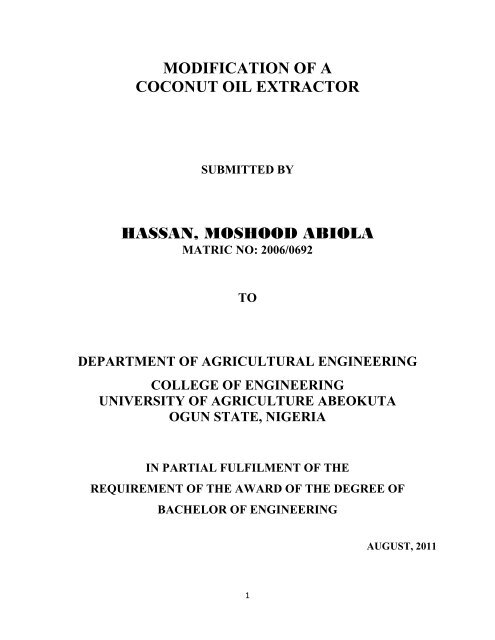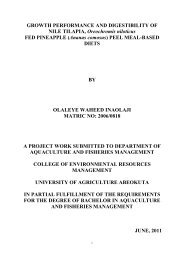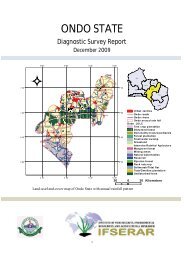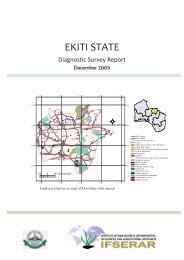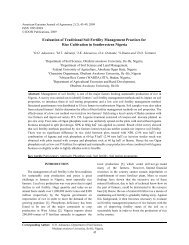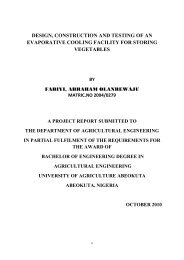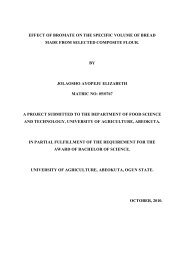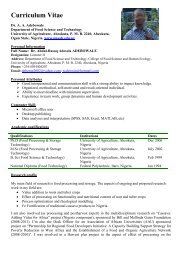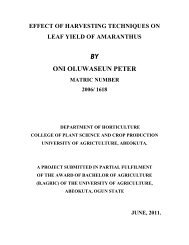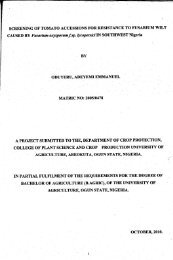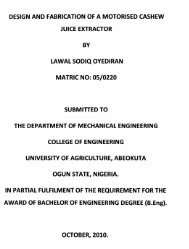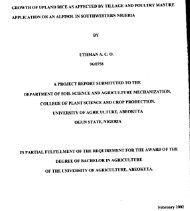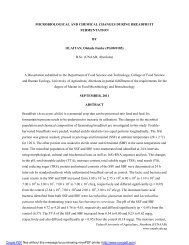modification of a coconut oil extractor hassan, moshood abiola
modification of a coconut oil extractor hassan, moshood abiola
modification of a coconut oil extractor hassan, moshood abiola
You also want an ePaper? Increase the reach of your titles
YUMPU automatically turns print PDFs into web optimized ePapers that Google loves.
MODIFICATION OF A<br />
COCONUT OIL EXTRACTOR<br />
SUBMITTED BY<br />
HASSAN, MOSHOOD ABIOLA<br />
MATRIC NO: 2006/0692<br />
TO<br />
DEPARTMENT OF AGRICULTURAL ENGINEERING<br />
COLLEGE OF ENGINEERING<br />
UNIVERSITY OF AGRICULTURE ABEOKUTA<br />
OGUN STATE, NIGERIA<br />
IN PARTIAL FULFILMENT OF THE<br />
REQUIREMENT OF THE AWARD OF THE DEGREE OF<br />
BACHELOR OF ENGINEERING<br />
AUGUST, 2011<br />
1
CERTIFICATION<br />
We certify that this project work was carried out by HASSAN MOSHOOD ABIOLA, in the<br />
Department <strong>of</strong> Agricultural Engineering, College <strong>of</strong> Engineering, University <strong>of</strong> Agriculture<br />
Abeokuta, Ogun State.<br />
........................................................ .............................................................<br />
Supervisor<br />
Head <strong>of</strong> Department<br />
ENGR. DR. T.M.A OLAYANJU<br />
ENGR. PROF. B.A. ADEWUNMI<br />
(Associate Pr<strong>of</strong>essor; MNSE, MNIAE, MNIFST)<br />
(FNSE, FNIAE, MNIFST)<br />
2
DEDICATION<br />
This project is dedicated to the Almighty Allah who has seen me through for period <strong>of</strong> my course<br />
and my late brother Mr. Adebowale Muideen Hassan. Though you have gone, but your virtues<br />
live with us.<br />
3
ACKNOWLEDGEMENT<br />
In the name <strong>of</strong> Allah, the most beneficient, the most merciful.<br />
My sincere gratitude goes to the Almighty Allah the Reckoner, the source <strong>of</strong> peace, the<br />
Guardian <strong>of</strong> faith, the protector, the creator <strong>of</strong> heaven and earth, the most exalted, the selfsubsisting,<br />
the first and last, the giver <strong>of</strong> live, the light <strong>of</strong> the heaven and earth and ever lasting<br />
one, who has been seeing me through over the year.<br />
My thanks go to my supervisor Engr. Dr. T.M.A. Olayanju who has help me through in<br />
supervising, check thouroughly, for their constructive criticism, suggestions and advice. He<br />
make a great difference in the success <strong>of</strong> this project.<br />
Also thanks go to my Head <strong>of</strong> Department Engr. Pr<strong>of</strong>. B.A. Adewunmi, all my lecturer,<br />
Dr. Adewunmi, Engr. Aderinlewo, Engr. Sobowale, Dr. Dairo, Engr. Ola, Engr. Dada, Engr.<br />
Adeosun, Pr<strong>of</strong>. Ajayi, Pr<strong>of</strong>. Ohu, for there support, effort and their contribution in my study<br />
throughout my staying in this school may the Almighty Allah blessed you all (Amen).<br />
My special thanks go to all members <strong>of</strong> Alhaji Hassan Shatoke family, my parent Alhaji<br />
and Alhaja Hassan Shatoke may the Almighty Allah let you reap the ripe fruits <strong>of</strong> your, joy<br />
(Amen), my brothers, Mr. Musiliu Hassan, Mr. Monsuru Hassan, Monsurat Hassan, Mrs.<br />
Morufat Adeola, Mr. Saheed Adeola, Nureni Hassan and to all my cousin and all my friends.<br />
I simply love you all. And may the Almighty Allah bless you all (Amen). Finally, I<br />
surrender all glory to the Almighty Allah for his provison and inspiration bestowed upon me.<br />
Thanks<br />
4
ABSTRACT<br />
A prototype <strong>of</strong> hydraulically operated <strong>coconut</strong> <strong>oil</strong> <strong>extractor</strong> was designed and fabricated.<br />
The machine can be used for other <strong>oil</strong>-bearing seeds such as groundnut and palm kernel. The<br />
machine is made up <strong>of</strong> a plunger, ram disc, expression chamber, and electric heater. The<br />
<strong>extractor</strong> can process 10kg <strong>coconut</strong> per hour.<br />
An efficiency <strong>of</strong> 15% was obtained from the <strong>coconut</strong> cake <strong>of</strong> 2.9kg (wet basis). While<br />
for the dry basis 40% <strong>of</strong> <strong>oil</strong> was obtained from <strong>coconut</strong> cake <strong>of</strong> 2.5kg.<br />
5
TABLE OF CONTENT<br />
TITLE PAGE.............................................................................................................................i<br />
CERTIFICATION.....................................................................................................................ii<br />
DEDICATION..........................................................................................................................iii<br />
ACKNOWLEDGEMENT........................................................................................................iv<br />
ABSTRACT..............................................................................................................................v<br />
TABLE OC CONTENTS.........................................................................................................vi<br />
CHAPTER ONE<br />
1.0 Introduction....................................................................................................................1<br />
1.1 Background.....................................................................................................................1-3<br />
1.2 Objectives <strong>of</strong> Work..........................................................................................................3<br />
1.3 Justification......................................................................................................................3<br />
CHAPTER TWO<br />
2.0 Literature Review............................................................................................................4<br />
2.1 General............................................................................................................................4-5<br />
2.2 Coconut Oil....................................................................................................................5-6<br />
2.3 Coconut Oil Characteristics and Uses...........................................................................6-8<br />
2.4 Coconut Oil Processing Technology.............................................................................8-16<br />
CHAPTER THREE<br />
3.0 Design Features and Analyses......................................................................................17<br />
3.1 The Improved Coconut Oil Extractor...........................................................................17<br />
3.2 Design Features.............................................................................................................17<br />
3.3 Design Conception........................................................................................................17<br />
6
3.4 Design Assumption......................................................................................................17-18<br />
3.5 Design Analysis...........................................................................................................18-24<br />
CHAPTER FOUR<br />
4.0 The Extractor: Description and Modification Details.................................................25<br />
4.1 Description <strong>of</strong> An Existing Extractor..........................................................................25<br />
4.2 Description/Modification Procedures.........................................................................25-35<br />
4.3 Assembly <strong>of</strong> the Machine...........................................................................................36-37<br />
4.4 Machine Maintenance.................................................................................................38<br />
4.5 Cost Estimated on the Developed Extractor..............................................................38-39<br />
CHAPTER FIVE<br />
5.0 Machine Testing and Performance.............................................................................40<br />
5.1 Testing and Performance............................................................................................40-46<br />
5.2 Discussion...................................................................................................................46<br />
CHAPTER SIX<br />
6.0 Conclusion and Recommandations.............................................................................47<br />
6.1 Conclusion..................................................................................................................47<br />
6.2 Recommandations........................................................................................................47<br />
REFERENCE.......................................................................................................................48-49<br />
APPENDIX...........................................................................................................................50-57<br />
T<br />
7
CHAPTER ONE<br />
1.0 INTRODUCTION<br />
1.1 Background Information<br />
The <strong>coconut</strong> (Cocos nucifera) is a member <strong>of</strong> the family Arecaceae (palm family) and is<br />
one <strong>of</strong> the nature’s gifts to mankind (William, 1997).<br />
It is the only accepted species in the genus Cocos, and is a large palm, growing up to<br />
30m tall, with pinnate leaves 4–6 m long, and pinnae 60–90 cm long; old leaves break away<br />
cleanly, leaving the trunk smooth and the term <strong>coconut</strong> can refer to the entire <strong>coconut</strong> palm, the<br />
seed, or the fruit, which is not a botanical nut (World Wildlife Fund, 2010).<br />
Coconut has been part <strong>of</strong> peoples’ diet and livelihoods in the tropical countries <strong>of</strong> Asia,<br />
the Pacific, South and Central America and Africa for thousands <strong>of</strong> years. In these areas, native<br />
meals are cooked with either <strong>coconut</strong> milk or <strong>coconut</strong> <strong>oil</strong>. The <strong>coconut</strong> palm is grown throughout<br />
the tropics for decoration, as well as for its many culinary and non-culinary uses; virtually every<br />
part <strong>of</strong> the <strong>coconut</strong> palm can be utilized by humans in some manner. However, the extent <strong>of</strong><br />
cultivation in the tropics is threatening a number <strong>of</strong> habitats such as mangroves; an example <strong>of</strong><br />
such damage to an ecoregion is in the Petenes mangroves <strong>of</strong> the Yucatan (Foale,2003).<br />
Coconut palms are believed to be largely cross-pollinated, although some dwarf varieties<br />
are self-pollinating. The meat <strong>of</strong> the <strong>coconut</strong> is the edible endosperm, located on the inner<br />
surface <strong>of</strong> the shell. Inside the endosperm layer, <strong>coconut</strong>s contain an edible clear liquid that is<br />
sweet, salty, or both (Fife, 2005).<br />
Although <strong>coconut</strong> meat contains less fat than many <strong>oil</strong>seeds and nuts such as almonds, it<br />
is noted for its high amount <strong>of</strong> medium-chain saturated fat and about 90% <strong>of</strong> the fat found in<br />
<strong>coconut</strong> meat is saturated, a proportion exceeding that <strong>of</strong> foods such as lard, butter, and tallow.<br />
8
There has been some debate as to whether or not the saturated fat in <strong>coconut</strong>s is less unhealthy<br />
than other forms <strong>of</strong> saturated fat (see <strong>coconut</strong> <strong>oil</strong>). Like most nut meats, <strong>coconut</strong> meat contains<br />
less sugar and more protein than popular fruits such as bananas, apples and oranges. It is<br />
relatively high in minerals such as iron, phosphorus and zinc (Nutritiondata.com).<br />
Coconut <strong>oil</strong> is extracted from the kernel or meat <strong>of</strong> matured <strong>coconut</strong> harvested from the<br />
<strong>coconut</strong> palm (Cocos nucifera). Throughout the tropical world it has provided the primary source<br />
<strong>of</strong> fat in the diets <strong>of</strong> millions <strong>of</strong> people for generations. It has various applications in food,<br />
medicine, and industry. Coconut <strong>oil</strong> is very heat stable so it makes an excellent cooking and<br />
frying <strong>oil</strong>. It has a smoke point <strong>of</strong> about 360°F (180°C). Because <strong>of</strong> its stability it is slow to<br />
oxidize and thus resistant to rancidity, lasting up to two years due to high saturated fat content.<br />
In the wet process, <strong>coconut</strong> milk is made first and then the <strong>oil</strong> is extracted from the milk (Fife<br />
2005).<br />
Coconut kernel is shredded and mixed with water. Then it is pressed and the <strong>oil</strong> is<br />
extracted. The resulting <strong>oil</strong>/water mixture is left to sit and it separates into two layers, watery on<br />
the bottom, creamy on top. The thicker cream is decanted <strong>of</strong>f the top and the original method <strong>of</strong><br />
separation involved heating or fermenting the milk to separate the <strong>oil</strong>. This traditional method<br />
made a very unstable <strong>oil</strong> with a short shelf life meant for quick daily use. Due to its miscible<br />
nature <strong>coconut</strong> <strong>oil</strong> is cannot be separated naturally from the cream (Ohler,1984).<br />
All high volume modern methods incorporate heating, fermentation, and or centrifugal<br />
force to separate the <strong>oil</strong> from the water. Some minor heating is generally done afterwards (<strong>of</strong>ten<br />
in a low temperature vacuum chamber) to drive <strong>of</strong>f excess moisture and produce a more purified<br />
product and to extend shelf life. Proper harvesting <strong>of</strong> the <strong>coconut</strong> (the age <strong>of</strong> a <strong>coconut</strong> can be 2<br />
to 20 months when picked; the time <strong>of</strong> harvesting makes a significant difference in the effiacy <strong>of</strong><br />
9
the <strong>oil</strong> making process) and the use <strong>of</strong> a centrifuge process make the best final extracted product<br />
(Woodruff,1970).<br />
1.2 Objective <strong>of</strong> the work<br />
The main objective <strong>of</strong> this project is to design and fabricate a <strong>coconut</strong> <strong>oil</strong> <strong>extractor</strong> that<br />
will be suitable for cottage scale <strong>oil</strong> production.<br />
The specific objectives are to:<br />
• To modify the existing design <strong>of</strong> a <strong>coconut</strong> <strong>oil</strong> <strong>extractor</strong>.<br />
• Evaluate the performance <strong>of</strong> the <strong>extractor</strong>.<br />
1.3 Justification<br />
Traditionally, virgin <strong>coconut</strong> <strong>oil</strong> is produced by fermentation method, where <strong>coconut</strong><br />
milk expelled from freshly harvested <strong>coconut</strong>s is fermented for 24-36 hr, and during this period,<br />
the <strong>oil</strong> phase gets separated from aqueous phase. Further, the resulting wet <strong>oil</strong> is slightly heated<br />
for a short time to remove the moisture and finally filtered. The main disadvantages <strong>of</strong> this<br />
process are low <strong>oil</strong> recovery and fermented odour, which masks the characteristic <strong>coconut</strong><br />
flavor <strong>of</strong> the <strong>oil</strong>.<br />
The construction <strong>of</strong> a <strong>coconut</strong> <strong>oil</strong> <strong>extractor</strong> will help in alleviating the suffering experienced by<br />
the use <strong>of</strong> traditional <strong>oil</strong> extraction method thereby improving the quality and quantity obtained<br />
and this will also bring about the production <strong>of</strong> high grade <strong>oil</strong><br />
10
CHAPTER TWO<br />
2.0 LITERATURE REVIEW<br />
2.1 General<br />
Philippines, Indonesia, India, Sri Lanka, Mexico, West Malaysia, and Papua & New<br />
Guinea are the 7 countries which produce major quantities <strong>of</strong> <strong>coconut</strong> in the world. Coconut is<br />
available in two forms viz., wet and dry materials commonly known as wet <strong>coconut</strong> and dry<br />
<strong>coconut</strong> or copra. The <strong>oil</strong> can be extracted from both these raw materials. However, in India and<br />
Srilanka, it is a general practice to use only copra for <strong>oil</strong> extraction and the <strong>oil</strong> is used for food<br />
and cosmetic purposes. In Phillippines, the <strong>oil</strong> is extracted from wet <strong>coconut</strong> also and is known<br />
as virgin <strong>coconut</strong> <strong>oil</strong>. In some countries solvent extraction <strong>of</strong> the dry <strong>coconut</strong> followed by<br />
refining, bleaching and deodorization is carried out to get the refined bleached and deodorized<br />
<strong>coconut</strong> <strong>oil</strong>. The technology for the production <strong>of</strong> <strong>coconut</strong> <strong>oil</strong> through expellers is well developed<br />
and many medium scale industries in India produce <strong>oil</strong> by this method. However, some small<br />
scale industries produce the <strong>oil</strong> by processing fresh <strong>coconut</strong> also using local expeller press.<br />
Problems <strong>of</strong> sediments and rancidity persist in these <strong>oil</strong>s (Cornelius, 1973).<br />
In the Cook Islands in the South Pacific, particularly Rarotonga Island, slices <strong>of</strong> fresh,<br />
mature <strong>coconut</strong> kernel are served with fruits every after meal. In India, the use <strong>of</strong> <strong>coconut</strong> for<br />
food and its applications in the Ayurvedic medicine, were documented in Sanskrit 4000 years<br />
ago (Kabara, 2000).<br />
Records show that in the United States, <strong>coconut</strong> <strong>oil</strong> was one <strong>of</strong> the major sources <strong>of</strong><br />
dietary fats, aside from dairy and animal fats, prior to the advent <strong>of</strong> the American edible <strong>oil</strong><br />
(soybean and corn) industry in the mid 1940s (Dayrit, 2005). Dayrit has reviewed the long<br />
history <strong>of</strong> usage and the diverse studies done to characterise and define the composition <strong>of</strong> the<br />
11
various components <strong>of</strong> the <strong>coconut</strong> tree, its fruit and the related products derived from it,<br />
established the <strong>coconut</strong>’s uniqueness and superiority among agricultural crops and every part <strong>of</strong><br />
the <strong>coconut</strong> tree and its fruit can be either consumed by humans or animals or converted into<br />
other valuable products. If properly utilised, the <strong>coconut</strong> has the highest economic value among<br />
the palm family. This is why the <strong>coconut</strong> is normally referred to as the Tree <strong>of</strong> Life, Man’s Most<br />
Useful Tree, King <strong>of</strong> the Tropical Flora, Tree <strong>of</strong> Abundance.<br />
2.2 Coconut Oil<br />
Oil obtained from the fresh, mature kernel (meat) <strong>of</strong> the <strong>coconut</strong> by mechanical or natural<br />
means, with or without the use <strong>of</strong> heat, without undergoing chemical refining, bleaching or dedourising,<br />
and which does not lead to the alteration <strong>of</strong> the nature <strong>of</strong> the <strong>oil</strong>. Virgin <strong>coconut</strong> <strong>oil</strong> is<br />
suitable for human consumption without the need for further processing (Fife, 2005).<br />
Virgin <strong>coconut</strong> <strong>oil</strong> consists mainly <strong>of</strong> medium-chain triglycerides, which are resistant to<br />
peroxidation. The saturated fatty acids in virgin <strong>coconut</strong> <strong>oil</strong> are distinct from animal fats, the<br />
latter constisting mainly <strong>of</strong> long-chain saturated fatty acids (Furman).<br />
The Philippine National Standard for Virgin Coconut Oil (PNS/BAFPS 22:2004/ ICS<br />
67.2000.10) <strong>of</strong>ficially defines Virgin Coconut Oil as: the purest form <strong>of</strong> <strong>coconut</strong> <strong>oil</strong>, essentially<br />
water clear or colourless. It contains natural Vitamin E and has not undergone any hydrolytic and<br />
atmospheric oxidation asdemonstrated by its very low, free fatty acid (FFA) content (even<br />
without refining) and low peroxide value. It has a fresh <strong>coconut</strong> aroma that can be mild to intense<br />
depending on the <strong>oil</strong> extraction process used. Virgin <strong>coconut</strong> <strong>oil</strong> differs greatly from traditionally<br />
produced, copraderived <strong>coconut</strong> <strong>oil</strong>, which must undergo chemical refining, bleaching and deodourisation<br />
processes to make it suitable for human consumption. RBD (Refined, Bleached and<br />
12
Deodourised) <strong>coconut</strong> <strong>oil</strong> made from copra, is yellow in colour, odourless, tasteless and does not<br />
contain natural Vitamin E, since this is removed when the <strong>oil</strong> is subjected to high temperature<br />
and various chemical processes.<br />
2.3 Coconut Oil Characteristics and Uses<br />
The degree <strong>of</strong> saturation and length <strong>of</strong> the carbon chain <strong>of</strong> the fatty acids comprising a<br />
particular fat or <strong>oil</strong> determines its properties, corresponding uses and its effects on human health.<br />
The more saturated the fat and the longer the chain, the harder the fat and the higher the melting<br />
point (Fife, 2001).<br />
Coconut <strong>oil</strong> is unique amid fats and <strong>oil</strong>s, as it contains the highest percentage <strong>of</strong> mediumchain<br />
fatty acids (MCFA) with a carbon-chain length <strong>of</strong> 8 to 12 carbon atoms. VCO behaves and<br />
metabolises differently in the human body to other saturated and unsaturated fats or <strong>oil</strong>s. MCFA<br />
in <strong>coconut</strong> <strong>oil</strong> is about 64%, with lauric fatty acid (C12) as the highest ranging from 47 to 53%<br />
depending on the <strong>coconut</strong> variety (Babayan, 1968).<br />
Babayan has reviewed that the most significant physical property <strong>of</strong> <strong>coconut</strong> <strong>oil</strong> is that<br />
unlike most fats, it does not exhibit gradual s<strong>of</strong>tening with increasing temperature, but passes<br />
rather abruptly from a brittle solid to a liquid within a narrow temperature range. In this respect,<br />
it resembles cocoa butter (Spectrum <strong>of</strong> Coconut Products, Philippine Coconut Authority,<br />
undated). Coconut <strong>oil</strong> is liquid at about 27°C or higher and solidifies at about 22°C when it has<br />
the consistency <strong>of</strong> butter in temperate countries.<br />
Copra-derived <strong>coconut</strong> <strong>oil</strong> has been produced and used commercially for almost a century<br />
as such, its use for edible and inedible applications has already been well established (Banzon,<br />
1990). For edible purposes, <strong>coconut</strong> <strong>oil</strong> is generally used as (Banzon, 1990):<br />
13
• A frying and cooking <strong>oil</strong> because <strong>of</strong> its excellent resistance to rancidity development.<br />
• It is also used as a substitute for expensive butter fat in filled milk, filled cheese and ice<br />
cream making these products cheaper without changing their palatability.<br />
• When hydrogenated, <strong>coconut</strong> <strong>oil</strong> is used as margarine, shortening and baking fat.<br />
Other edible applications <strong>of</strong> <strong>coconut</strong> <strong>oil</strong> are (Banzon, 1990):<br />
• As a source <strong>of</strong> fat in infant formulas and baby foods because <strong>of</strong> its easy digestibility and<br />
absorbability;<br />
• As a spray <strong>oil</strong> for crackers, cookies and cereals to enhance flavour, increase shelf-life and<br />
impart a glossy appearance;<br />
• As an ingredient in confectionaries such as candy bars, t<strong>of</strong>fee, caramels, etc.<br />
The Spectrum <strong>of</strong> Coconut Products states that in food preparations and in diet, <strong>coconut</strong><br />
<strong>oil</strong> performs the following functions (Enig, 2001).<br />
• It serves as an important source <strong>of</strong> energy in the diet.<br />
• It supplies specific nutritional requirements.<br />
• It provides a lubricating action in dressings or leavening effect in baked items.<br />
• It acts as carrier and protective agent for fat-soluble vitamins.<br />
• It enhances the flavour <strong>of</strong> food.<br />
The major inedible use <strong>of</strong> <strong>coconut</strong> <strong>oil</strong> is as a raw material in the manufacture <strong>of</strong> laundry<br />
and bath soaps; as <strong>coconut</strong> chemicals for production <strong>of</strong> biodegradable detergents, shampoos,<br />
shower gels and other cleaning agents; for cosmetics and t<strong>oil</strong>etries; for foam boosting <strong>of</strong> non<strong>coconut</strong><br />
<strong>oil</strong> based soaps; for the production <strong>of</strong> synthetic resins and plasticisers for plastic etc<br />
(Pattra, 2004).<br />
14
In Thailand, <strong>coconut</strong> <strong>oil</strong> is mixed with 10 to 20% kerosene, settled to remove free fats,<br />
filtered and used as a diesel fuel substitute. In Vanuatu and other Pacific Islands, <strong>coconut</strong> <strong>oil</strong><br />
isused directly as a substitute for diesel (Bawalan, 2005).<br />
The current emerging major uses <strong>of</strong> virgin <strong>coconut</strong> <strong>oil</strong> (Fife,2004) are as:<br />
• A hair and skin conditioner;<br />
• An <strong>oil</strong> base for various cosmetic and skin care products;<br />
• A carrier <strong>oil</strong> for aromatherapy and massage <strong>oil</strong>s;<br />
• A nutraceutical and functional food.<br />
2.4 Coconut Oil Processing Technology and Equipment<br />
Virgin <strong>coconut</strong> <strong>oil</strong> can be produced directly from the fresh comminuted (grated, chopped,<br />
granulated) <strong>coconut</strong> meat, or from <strong>coconut</strong> milk, or from <strong>coconut</strong> milk residue. The choice <strong>of</strong> the<br />
technology to be adopted, depends to a great extent on the scale <strong>of</strong> operation, the degree <strong>of</strong><br />
mechanisation desired, the amount <strong>of</strong> investment available and the demands <strong>of</strong> the prospective<br />
buyer. The scale <strong>of</strong> operation to be implemented is significantly dependant on the available<br />
<strong>coconut</strong> supply base (Weiss, 1999).<br />
Oil can be extracted manually by pressing s<strong>of</strong>ter <strong>oil</strong>seeds and nuts, such as roundnuts and<br />
shea nuts, whereas harder, more fibrous materials such as copra and sunflower seed can be<br />
processed using Ghanis. Pulped or ground material is loaded into a manual or hydraulic press to<br />
squeeze out the <strong>oil</strong>-water emulsion. This is more efficient at removing <strong>oil</strong> than traditional hand<br />
squeezing, allowing higher production rates. Fresh <strong>coconut</strong> meat is removed from the shell using<br />
a manual or (Weiss, 1999) motorised grater (Fig. 2.1).<br />
15
Fig. 2.1: A manual <strong>coconut</strong> grater<br />
Adapted from UNIFEM (1986)<br />
16
UNIFEM (1987) classified expression devices in three categories viz: plate presses,<br />
ghanis and expellers. Oil plate presses are <strong>of</strong> two types: screw press and hydraulic press.<br />
Presses have a number <strong>of</strong> different designs, commonly based on a bridge press. In all<br />
types, a batch <strong>of</strong> raw material is placed in a heavy-duty perforated metal ‘cage’ and pressed by<br />
the movement <strong>of</strong> a plunger. The amount <strong>of</strong> material in the cage varies from 5-30 kg with an<br />
average <strong>of</strong> 20 kg. Layer plates can be used in larger cages to provide a constant pressure through<br />
the bulk <strong>of</strong> material and speed up removal <strong>of</strong> <strong>oil</strong>. The pressure should be increased slowly to<br />
allow time for the <strong>oil</strong> to escape. Screw types are more reliable than hydraulic types but are<br />
slower and produce less pressure. Except where a lorry jack is used (Fig. 2.2), hydraulic types<br />
are more expensive, need more maintenance, and risk contaminating <strong>oil</strong> with poisonous<br />
hydraulic fluid (Potts, 1993).<br />
In a screw press, steamed beniseed is pressed slowly and with pressure by a plunger force<br />
down by screw and into a cylinder with large number <strong>of</strong> small holes (Plate 2.1). Capacities <strong>of</strong><br />
screw presses depend upon the size <strong>of</strong> the cage, an average being about 1.5 kg per batch<br />
(Potts, 1993). Potts also reviewed that in an hydraulic press, pressure is exerted by an hydraulic<br />
device such as a lorry jack. It requires a heavy - rigid framed structure . Hydraulic presses<br />
generate greater pressure than plate presses. However, the hydraulic fluid should be prevented<br />
from coming in contact with the <strong>oil</strong>seed.<br />
Ram press is a long pivoted lever moves a piston backwards and forwards inside a<br />
cylindrical cage constructed from metal bars spaced to allow the passage <strong>of</strong> <strong>oil</strong>. At one end <strong>of</strong><br />
the piston's stroke, it opens an entry port from the seed hopper so that seed enters the press<br />
cage(plate 2.1).When the piston is moved forward, the entry port is closed and the <strong>oil</strong>seed is<br />
compressed in the cage. As a result, <strong>oil</strong> is expelled from the <strong>oil</strong>seed and emerges through the<br />
17
Fig. 2.2: Oil press with a hydraulic jack<br />
Adapted from Kickstart (1993)<br />
18
Pla<br />
te 2.1: Ram press<br />
Adapted from kickstart (1993)<br />
19
gaps in the cage, compressed seed is pushed out through a circular gap at the end <strong>of</strong> the cage.<br />
The width <strong>of</strong> this gap, which can be varied using an adjustable pressure cone, controls the<br />
operating pressure <strong>of</strong> the press. The design <strong>of</strong> the press is such that it can achieve operating<br />
pressures in excess <strong>of</strong> those obtained in most manually operated cage presses and as high as<br />
those in small expellers. The ram press has a low seed throughput but has the advantage <strong>of</strong><br />
continuous operation. The ram press was developed in Tanzania specifically for processing a<br />
thin shelled high <strong>oil</strong> content variety <strong>of</strong> sunflower seed. The technique can also be used for copra,<br />
groundnuts and sesame (Weiss, 1999).<br />
Ghanis are widely used in Asia but less so in other areas. A heavy wooden or metal pestle<br />
is driven inside a large metal or wooden mortar (Fig. 2.3a). The batch <strong>of</strong> raw material is ground<br />
and pressed and the <strong>oil</strong> drains out. They have relatively high capital and maintenance costs and<br />
need skilled operators to achieve high <strong>oil</strong> yields. The ghani (mechanised extraction) consists <strong>of</strong> a<br />
large mortar and pestle, the mortar being fixed in the ground and the pestle being moved within<br />
the mortar by animal traction (donkey or mule) or (more commonly) a motor. Oilseeds are<br />
placed in the mortar and the pestle grinds the material to remove the <strong>oil</strong>. The <strong>oil</strong> runs out <strong>of</strong> a<br />
hole in the bottom <strong>of</strong> the mortar and the cake is scooped out by hand. This method is slow and<br />
requires two animals, replacing the tired one with another after about 3-4 hours <strong>of</strong> work.<br />
Motorised ghanis (Fig. 2.3b) are faster than manual or animal types but are more expensive and<br />
their higher capital and operating costs will require a larger scale <strong>of</strong> production for pr<strong>of</strong>itability<br />
(Ghani, 1993).<br />
20
(a)<br />
(b)<br />
Fig. 2.3 (a) Animal powered extraction (b) Motorise extraction<br />
Adapted from FAO (1993)<br />
21
An expeller consist <strong>of</strong> a helical thread (worm assembly) which revolves concentrically<br />
within pertorated cylinder (the cage or barrel). The barrel is usually formed by a series <strong>of</strong> axiallyplaced<br />
lining bars contained within a robust frame. Heated <strong>oil</strong>seeds enter one end <strong>of</strong> the barrel<br />
through the feed inlet and are conveyed by the rotating worm assembly to the discharge end.<br />
With any power-driven equipment, it is important to consider how the equipment will be<br />
repaired as it becomes worn (Plate 2.2). Local refurbishment is normally cheaper than importing<br />
spare parts (Fellow and Hampton, 2002).<br />
22
Plate 2.2: Rosedowns Max<strong>oil</strong> press.<br />
(Fellow and Hampton, 2002).<br />
23
CHAPTER THREE<br />
3.0 DESIGN FEATURES AND ANALYSES<br />
3.1 The improved <strong>coconut</strong> <strong>oil</strong> <strong>extractor</strong><br />
The <strong>coconut</strong> <strong>oil</strong> <strong>extractor</strong>s are capital intensive and <strong>of</strong> complex design and construction.<br />
Although these are <strong>of</strong> high production capacities and are appropriate for the producer on small<br />
scale with limited supply <strong>of</strong> <strong>coconut</strong>.<br />
A functional, manually hydraulic operated <strong>oil</strong> <strong>extractor</strong> containing a finely perforated<br />
cylinder which carries an internal pressure plate that can be moved upwards and downwards<br />
within the cylinder was modified.<br />
3.2 Design features<br />
The following points are considered:<br />
i. The design should be simple and the construction should be at minimum cost.<br />
ii.<br />
Power requirement to operate the equipment should be minimal. This is to be<br />
achieved by providing means for efficient power utilization.<br />
iii.<br />
The component parts should be easily replaceable in case <strong>of</strong> any damage.<br />
3.3 Design conception<br />
Base on the above, the following specifications were conceived:<br />
• The <strong>extractor</strong> is a cage/screw press type. It is to consist plunger (shaft) with an expression<br />
chamber. The plunger (constitute hub and shaft) is to be bolted at the top <strong>of</strong> the frame.<br />
• The input capacity <strong>of</strong> the <strong>extractor</strong> is to be 10kg per batch.<br />
3.4 Design assumption<br />
For simplicity <strong>of</strong> design, the following assumptions are made;<br />
24
• A grown up man <strong>of</strong> average power <strong>of</strong> 0.05kw can conveniently apply a hand force <strong>of</strong><br />
210N at a speed <strong>of</strong> 60rpm for a time duration depending on the material being<br />
compressed (Sanders and McCormick, 1987).<br />
• In one revolution <strong>of</strong> the screw shaft, discharge <strong>of</strong> <strong>coconut</strong> <strong>oil</strong> is advanc e by one pitch <strong>of</strong><br />
the hydraulic pump.<br />
3.5 Design analyses<br />
The <strong>coconut</strong> <strong>oil</strong> <strong>extractor</strong> made up <strong>of</strong> the following components:<br />
• Hydraulic pump<br />
• Plunger/ram (constitute hub and shaft)<br />
• Ram disc<br />
• Expressing chamber<br />
• Electric heater<br />
The design <strong>of</strong> each components is described as follows:<br />
3.5.1 Hydraulic pump<br />
3.5.2 Power requirement<br />
A<br />
F<br />
X<br />
At point end A <strong>of</strong> the plumger (shaft), a force F is applied at distance x from the axis <strong>of</strong><br />
the ram disc attached to the bottom <strong>of</strong> expression chamber where the <strong>coconut</strong> materials being<br />
compressed. The turning moment transmitted by the shaft is, T = Fx.<br />
25
From section 3.4, a force <strong>of</strong> 210N can be applied by a man at a speed <strong>of</strong> 60rpm and at a distance<br />
0.2m from the axis and tangential to the shaft.<br />
i.e T = 210 x 0.2<br />
= 42Nm ....................................................................(3.1)<br />
The pressure required required from the pump to express the <strong>coconut</strong> <strong>oil</strong> from the<br />
<strong>coconut</strong> base on the maximum applicable load is given as:<br />
Presssure, P = F / A .....................................................................3.2<br />
P = pressure required from the pump<br />
F = 210N<br />
A = πd 2 / 4<br />
where d = diameter <strong>of</strong> the expression chamber which is 240mm<br />
A = 3.142 x 0.24 2 / 4<br />
=0.0452m 2<br />
P= 210 / 0.0452 ............................................................................................................3.3<br />
P= 4.6KN/ m 2<br />
Therefore, the pressure required from the pump to extract <strong>oil</strong> from the <strong>coconut</strong> cake is 4.6KN/m 2<br />
The power requirement to pump the hydraulic through the handle and eventually express<br />
the <strong>coconut</strong> <strong>oil</strong> from the <strong>coconut</strong> based on the maximum applicable load is given as;<br />
Px = 2πNT...................................................................................................................3.4<br />
Where;<br />
26
N = Speed <strong>of</strong> rotation = 60rpm (section 3.4)<br />
T = Torque on the shaft = 105Nm<br />
:- Px = 2 x 3.142 x 60 / 60 x 42<br />
= 263.9watts<br />
= 0.263Kw ................................................................................................3.5<br />
3.5.3. Design <strong>of</strong> Shaft<br />
The <strong>extractor</strong> shaft is to be designed on the basis <strong>of</strong> torsional load only. This involve<br />
analyses based on strength and rigidity.<br />
3.5.4. Strength criterion<br />
The required diameter for a solid shaft having torsional load only is obtained from ASME<br />
code equation (Hall, et al., 1980) as follow:<br />
D 3 = 16T / S ................................................................................3.6<br />
Where,<br />
S = allowable stress = 55Mpa (for shaft without keyway)<br />
T = Torque<br />
D 3 = 16 x 42 / 55x10<br />
6<br />
= 1.22 x10 -5<br />
D = (1.22 x10 -5 ) 1/3<br />
D = 0.023m<br />
:- D = 23mm (says 25mm)................................................................................3.7<br />
27
3.5.5 Torsional deflection<br />
The design <strong>of</strong> shaft for torsional rigidity is based on the permissible angle <strong>of</strong> twist. The<br />
permissible angle <strong>of</strong> twist for steel is 3deg/m (Surrender, 1979).<br />
For limiting the twisting to the given limit, the angle <strong>of</strong> twist (radian)<br />
θ = TL / GJ .......................................................................................................3.8<br />
where,<br />
T = Torque (Nm) = 42Nm (3.5.2.1)<br />
L = Length <strong>of</strong> shaft (m) = 0.6m (assumed)<br />
J = Polar moment <strong>of</strong> inertia for the shaft section = πD 4 / 32 (for circular shaft)<br />
G = Modulus <strong>of</strong> rigidity <strong>of</strong> the shaft material = 80GN/m 2<br />
From the above equation, the polar moment <strong>of</strong> inertial will be equal to:<br />
J = TL / Gθ<br />
πD 4 / 32 = 42 x 0.6 x 180 / 80x10<br />
9<br />
x 3 = 1.9x10 -8<br />
D 4<br />
= 32 x1.9x10-8 / π<br />
D 4 = 1.92 x 10 -8<br />
D = 0.021m = 21mm.......................................................................................3.9<br />
For both stress and the twist to be within permissible limit, a steel shaft (plunger) <strong>of</strong> 25mm<br />
diameter is choosen.<br />
3.5.5 Weight <strong>of</strong> Shaft<br />
28
The weight <strong>of</strong> the shaft are expressed below:<br />
W s = S 8 V 8 g ................................................................................................................3.10<br />
S 8 = density <strong>of</strong> shaft = 7800kg/m 3 for steel<br />
V 8 = Volume <strong>of</strong> shaft = πD 2 L/ 4<br />
W s = π (0.025) 2 x 0.6/ 4<br />
= 2.9 x10 -4<br />
g = acceleration due to gravity = 9.81m/s 2<br />
W s = 7800 x2.9 x10 -4 x 9.91<br />
= 22.4N ...............................................................................................................3.10<br />
3.5.6. Ram disc<br />
The ram disc (working like a piston) is expected to compress the material fed into the<br />
expressing chamber as a result <strong>of</strong> the axial pressure form the hydraulic pump, the material being<br />
extracted at the same time exert a pressure equal but opposite on the point face.<br />
This force and pressure consideratioins necessitate the choice <strong>of</strong> a rigid and strong<br />
material for the point. A stainless steel <strong>of</strong> 240mm in diameter and 40mm long is choosen.<br />
The weight <strong>of</strong> the piston,<br />
W p = S p V p g .......................................................................................................3.11<br />
S p = density <strong>of</strong> ram disc material = 7800kg/m 3<br />
V p = volume <strong>of</strong> piston = π (0.24)2 x 0.04 / 4<br />
= 1.81 x 10 -3 m 3<br />
29
Therefore, W p = 7800 x 1.81 x 10 -3 x 9.81<br />
= 137.7N .........................................................................................3.12<br />
3.5.7 The expressing chamber<br />
The chamber is to to be designed on the basis <strong>of</strong> internal pressure only. If the housing is<br />
treated as a thin walled cylinder, then using the standard stress (stiffness) analysis applied to thin<br />
walled pressure vessels (Surrender, 1979), the maximum shear stress,<br />
σ = Pr/ 4t .........................................................................................3.13<br />
where;<br />
σ = The maximum stress the cylinder will be subjected to at failure by yield. For steel, the<br />
ultimate or yield sstress is 140MN/m 2 the stress using a factor <strong>of</strong> safety <strong>of</strong> 2 is 70MN/m 2 .<br />
P = Internal pressure which equal to 35MN/ m 2<br />
r = internal radius <strong>of</strong> the cylinder = 0.120m<br />
t = thickness <strong>of</strong> the cylinder<br />
70 x10 6 = 35x 10 6 x 0.120/ 4t<br />
t = 35x 10 6 x 0.120<br />
/ 70 x10<br />
6<br />
x4<br />
= 0.15m (15mm) .............................................................................3.14<br />
From the design, expression chamber <strong>of</strong> 15mm thickness is require to widstand the pressure<br />
which will be too costly for stainless steel and therefore stainless steel cylinder <strong>of</strong> 5mm was<br />
selected and mild steel plate <strong>of</strong> 10mm thinkness were cut and place at the bottom <strong>of</strong> expression<br />
30
chamber (i.e. expression chamber sit on the mild steel plate which resist the pressure as the<br />
materials being compressed).<br />
3.5.8. Torsional Springs/Returning spring<br />
Helical spring made up <strong>of</strong> circular diameter was selected based on the following equation.<br />
T = W ( D / 2 ) { Khurmi, Guputa (1979)} ...........................................3.15<br />
Where T = Torque (N.m)<br />
D = Mean Diameter <strong>of</strong> the spring c<strong>oil</strong><br />
W = Axial load on the spring<br />
From the design T = 42Nm, W= 210N<br />
D = 42x 2 /210<br />
= 0.4m<br />
31
CHAPTER FOUR<br />
4.0 THE EXTRACTOR: DESCRIPTION AND MODIFICATION DETAILS<br />
4.1 Features <strong>of</strong> An Existing Extractor<br />
The existing <strong>extractor</strong> consists <strong>of</strong> four integral parts namely: the expression chamber, the<br />
plunger, the compression plate, and the frame. The major problem facing the existing <strong>extractor</strong><br />
are listed below.<br />
• Instability <strong>of</strong> plunger<br />
• Leakages <strong>of</strong> hydraulic <strong>oil</strong><br />
• Light thinkness <strong>of</strong> expressing chamber which can cause damages <strong>of</strong> the chamber<br />
during compression.<br />
• Irregularity in shape <strong>of</strong> compression plate or ram press<br />
• No electic heater was supplied with design<br />
4.2 Description/Modification Procedure<br />
A prototype hand operated hydraulic <strong>of</strong> an existing (Plate 4.1a) <strong>oil</strong> <strong>extractor</strong> was<br />
modified (Plate 4.1b) using available materials. Appendix 3 shows the orthographic and<br />
isometric views <strong>of</strong> the <strong>extractor</strong>.<br />
The modified <strong>extractor</strong> consist <strong>of</strong> five integral parts namely: The frame, The power<br />
transmission shaft or plunger, expression chamber, compression plate (ram press) and electric<br />
heater devices. The procedure <strong>of</strong> these components is described below to show the sequence <strong>of</strong><br />
operation performed on each.<br />
32
(a)<br />
(b)<br />
Plate 4.1(a) An existing <strong>coconut</strong> <strong>oil</strong> <strong>extractor</strong> (b) Modified <strong>coconut</strong> <strong>oil</strong> <strong>extractor</strong><br />
33
4.2.1 The Frame<br />
The frame was fabricated with 4inches channel (50mm x 100mm x 50mm in dimension).<br />
The frame is rectangular in shape having length and breadth <strong>of</strong> 1036mm and 600mm<br />
respectively. Most <strong>of</strong> the joints were fastened together by bolt and nut and other joint by electric<br />
arc welding.<br />
4.2.2 The Power Transmission Shaft<br />
From the design, plunger <strong>of</strong> 25mm shaft was selected which used to transmitted force<br />
needed to compressed <strong>coconut</strong> cake from the hydraulic pump. The ends <strong>of</strong> the plunger was hang<br />
at the top <strong>of</strong> the frame and fastened with bolt and nut (25mm), due to instablity <strong>of</strong> the plunger <strong>of</strong><br />
an existing <strong>oil</strong> <strong>extractor</strong> (Plate 4.2a), flat bar <strong>of</strong> 8mm thickness was fabricated and fastened to the<br />
upper end <strong>of</strong> the plunger/ram by 10mm bolt and nut, finally fastened to the frame (Plate 4.2.b)<br />
34
(a)<br />
(b)<br />
Plate 4.2(a) An existing <strong>coconut</strong> <strong>oil</strong> <strong>extractor</strong> (b) Modified <strong>coconut</strong> <strong>oil</strong> <strong>extractor</strong><br />
35
4.2.3 The Expression Chamber<br />
The expression chamber comprises <strong>of</strong> two cylinder (This expression chamber was<br />
modified (Plate 4.4) by reducing the size <strong>of</strong> the existing one), the first cylinder <strong>of</strong> existing <strong>oil</strong><br />
<strong>extractor</strong> (Plate 4.3) was fabricated with perforated materials (mesh) made <strong>of</strong> 240mm in<br />
diameter, 300mm long and 2mm thick which now reduced to 178mm long having the same<br />
diameter and thickness. The second expression chamber <strong>of</strong> existing <strong>oil</strong> <strong>extractor</strong> are non<br />
perforated cylinder with 260mm in diameter, 300mm long and 3mm thick which also reduced to<br />
165mm long having the same diameter and thickness. Gate valve ( 1 / 2 inches) was welded to the<br />
bottom end <strong>of</strong> the second expression chamber (non perforated cylinder). This gate valve (which<br />
can be opened or closed) function as the outlet for collecting the <strong>coconut</strong> <strong>oil</strong> at the end <strong>of</strong> each<br />
extraction process.<br />
36
D<br />
Plate 4.3: An Existing Coconut Oil Extractor<br />
D = expression chamber<br />
37
D<br />
Plate 4.4: Modified Coconut Oil Extractor<br />
D = expression chamber<br />
38
4.2.4 Compression plate/Ram plate<br />
The compression plate <strong>of</strong> the existing <strong>extractor</strong> (Plate 4.5a) was not perfectly sphere (i.e.<br />
irregular shape) which will caused escaping <strong>of</strong> <strong>coconut</strong> cake during compression which will<br />
reduced the efficiency <strong>of</strong> the <strong>extractor</strong>. Due to this, compression/ram plate was redesign and<br />
fabricated. Stainless steel <strong>of</strong> 8mm thickness and 240mm diameter used for the fabrication <strong>of</strong> the<br />
compression plate or ram disc (Plate 4.5b) and this was achieved by cutting 240mm diameter<br />
from materials using cutting disc. Stainless pipe <strong>of</strong> 8mm thickness and 30mm long was weld at<br />
the centre <strong>of</strong> the compression plate which aids easy attachment to the plunger by 10mm by<br />
25mm bolt and nut through the hole drilled on the pipe and shaft(plunger).<br />
39
B<br />
B = Compression/ ram plate<br />
(a)<br />
B<br />
(b)<br />
Plate 4.5(a) An existing <strong>coconut</strong> <strong>oil</strong> <strong>extractor</strong> (b) Modified <strong>coconut</strong> <strong>oil</strong> <strong>extractor</strong><br />
40
4.2.5 Electric heater<br />
The existing <strong>oil</strong> <strong>extractor</strong> have no electric heater therefore, electric heater (Plate 4.6) <strong>of</strong><br />
1500watts capacity was attached to the modified <strong>oil</strong> <strong>extractor</strong> having thermostat for controlling<br />
temperature needed for the extraction <strong>of</strong> the <strong>coconut</strong> <strong>oil</strong>. Electric heater space was created below<br />
the compression stand (expression chamber sit on this stand) and the compression stands used in<br />
wisthand pressure from the hydraulic pump.<br />
41
Electric heater<br />
Plate 4.6: Electric heater<br />
42
4.3 Assembly <strong>of</strong> the Machine<br />
The following procedure should followed in order to assemble the machine (Plate 4.6):<br />
• Bolt the plunger at the top <strong>of</strong> the frame with 20mm bolt<br />
• Attached the ram press/disc to the plunger ends by fastened it with 20mm bolt and nut<br />
• Attached the returning spring to the hangs provided on the ram disc and the frame.<br />
• Set the perforated cylinder into the cylinder and set it on the compression stand.<br />
• Put the electric heated into it space provided under the compression stand.<br />
43
Plate 4.7: Assembly <strong>of</strong> the Extractor<br />
44
4.4 Machine Maintenance<br />
• The major maintenance <strong>of</strong> <strong>oil</strong> extrator required thorough cleaning <strong>of</strong> the expression<br />
chamber, compression/ram disc at the end <strong>of</strong> each day work.<br />
• When the machine is no more compressing as before, check and refilled the <strong>oil</strong> in the<br />
hydraulic pump.<br />
4.5 Cost Estimation <strong>of</strong> the Developed Extractor<br />
The cost <strong>of</strong> construction <strong>of</strong> the <strong>coconut</strong> <strong>oil</strong> <strong>extractor</strong> was computed by considering the<br />
individual component parts, and the expenses due to machining, welding and painting operation.<br />
The cost are shown in the table 4.5 below:<br />
45
Table 4.5: Bill <strong>of</strong> Materials for the Construction <strong>of</strong> the Coconut Oil Extractor<br />
QTY DESCRIPTION RATE (N) AMOUNT (N)<br />
1 Hydrualic ram 12,000 12,000<br />
1 50x50x50 (4inch)U Channel 7,200 7,200<br />
1 Perforated cylinder (240mm in diameter) 6,200 6,200<br />
1 Cylinder (260mm in diameter) 6,100 6,100<br />
1 50x50 (4inch) Angle iron 3,000 3,000<br />
1 Electric heater with thermostart 5,500 5,500<br />
1 Gate valve ( 1 / 2 Inch) 400 400<br />
2 Torsional Spring 500 500<br />
12 20mm bolt and nut 30 360<br />
12 16mm bolt and nut 20 240<br />
½ Mild Steel plate (3mm thick) 3,000 3,000<br />
12 12mm bolt and nut 20 240<br />
1 Packet <strong>of</strong> stainless electrode (Gauge 12) 4,500 4,500<br />
Painting 2,500 2,500<br />
20ft 4inch Angle iron 2,200 2,200<br />
Transportation 3,000 3,000<br />
TOTAL 54,000<br />
46
CHAPTER FIVE<br />
5.0 MACHINE TESTING AND PERFORMANCE<br />
5.1 Testing and Performance<br />
Coconut nut were obtained from the Kuto market in Abeokuta. These <strong>coconut</strong>s were<br />
weighed. An uncracked <strong>coconut</strong> weighs about 1.4kg. Since the <strong>coconut</strong>s were <strong>of</strong> different sizes,<br />
their weight varies between 0.9 - 1.4kg and grated manually. The testing were carried out for<br />
both wet and copra <strong>coconut</strong> and the colour <strong>of</strong> the sample was notice at different temperature as<br />
shown in fig. 5.1 and fig 5.2 below until golden colour was observed.<br />
For wet basis, the uncracked <strong>coconut</strong> was weighed to be 3.4kg and after cracked (splitted)<br />
and grated it weighed 2.9kg. The grated <strong>coconut</strong> meat was then compressed in the expression<br />
chamber and heat was applied for the extraction <strong>of</strong> the <strong>coconut</strong> <strong>oil</strong>.<br />
The following procedure was carried out during the testing <strong>of</strong> the machine for dry<br />
<strong>coconut</strong> meat (copra):<br />
• Fully matured nuts (Plate 5.1) was selected and weighed.<br />
• It was split (Plate 5.2) and grated (Plate 5.3, Plate 5.4) manually and weighed to be 8kg<br />
• Grated <strong>coconut</strong> meat was heated to a moisture content <strong>of</strong> 10 – 12% at a temperature <strong>of</strong><br />
70– 75°C (Anzaldo, F.E. et al, 1985) by using an indirect type <strong>of</strong> hot air dryer (copra<br />
weigh 2.5kg).<br />
• Oil extraction was extracted by using hydraulic operated <strong>coconut</strong> <strong>oil</strong> <strong>extractor</strong> (plate<br />
5.5).<br />
• Oil extraction was done when the moisture content <strong>of</strong> the material is relatively high, <strong>oil</strong><br />
is then heated by applying heat through the electric heater to ensure that all residual<br />
moisture is removed to prolong the shelf-life <strong>of</strong> the <strong>coconut</strong> <strong>oil</strong>.<br />
47
• The <strong>oil</strong> is left for a maximum <strong>of</strong> 6 hours to allow sufficient time for the trapped foots to<br />
settle (Plate 5.6).<br />
• Filtration <strong>of</strong> the <strong>oil</strong> is done using a three-layered filter cloth bag.<br />
• The extracted <strong>oil</strong> was then package and stored.<br />
FRESH DE-HUSKED NUT<br />
SPLITING<br />
GRATING<br />
DRYING (10to 12 Moisture content)<br />
PRESSING<br />
OIL DRYING<br />
FILTRATION<br />
Chart showing the extraction process<br />
48
Plate 5.1 Plate 5.2<br />
Plate 5.3 Plate 5.4<br />
Plate 5.5<br />
49
Plate 5.6<br />
50
5.1.1 Result obtained from the wet basis<br />
Wet <strong>coconut</strong> weigh 2.9kg<br />
Mixture <strong>of</strong> <strong>coconut</strong> milk and <strong>oil</strong> after extraction= 1.5kg<br />
Table 5.1<br />
Showing the result <strong>of</strong> the test for wet basis<br />
WEIGHT TEMP. COLOUR WEIGHT OF WEIGHT OF QTY OF OIL<br />
OF ( 0 C) OBSERVED COCONUT CAKE MIXTURE OF OBTAINED<br />
CAKE DURING LEFT AFTER AND OIL BEFORE AFTER<br />
EXTRACTION EXTRACTION FILTRATION FILTRATION<br />
(Kg) (Kg) (Kg) (Kg)<br />
2.9 25-60 White (milky solution) 1.28 1.6 0.04<br />
2.9 61-100 White (milky solution) 1.37 1.5 0.09<br />
2.9 101-114 White and Golden 1.27 1.6 0.1<br />
2.9 115 Golden 1.35 1.5 0.4<br />
From the table above it show that hightest percentage <strong>of</strong> <strong>oil</strong> was obtained at 115 0 C which<br />
is 0.4 Kg (it was extracted for 25min) and above this tempetrature the <strong>coconut</strong> cake burnt and no<br />
<strong>oil</strong> was obtained. The table above also show that the <strong>coconut</strong> <strong>oil</strong> will be best extracted at 115 0 C<br />
for wet basis. The <strong>oil</strong> was obtained after settling <strong>of</strong> misture <strong>of</strong> co<strong>coconut</strong> milk and <strong>oil</strong> for about<br />
an hours and filtrated, 0.8kg <strong>of</strong> <strong>coconut</strong> <strong>oil</strong> was obtained.<br />
Efficiency <strong>of</strong> extraction obtained during the wet basis<br />
Efficiency = weight <strong>of</strong> the <strong>oil</strong> obtained<br />
Weight <strong>of</strong> the wet <strong>coconut</strong><br />
= 0.4 x 100<br />
2.9<br />
51
= 15%<br />
5.1.2 Result obtained from the copra (Dry basis)<br />
Wet cocotnut weigh = 8.5kg<br />
After drying (copra) = 2kg<br />
Mixture <strong>of</strong> <strong>coconut</strong> milk and <strong>oil</strong> = 1.5kg<br />
Oil obtained after settling and filtration =0.8kg<br />
Table 5.2<br />
Showing the result <strong>of</strong> the test for dry basis (copra)<br />
WEIGHT TEMP. COLOUR WEIGHT OF WEIGHT OF QTY OF OIL<br />
OF ( 0 C) OBSERVED COCONUT CAKE MIXTURE OF OBTAINED<br />
CAKE DURING LEFT AFTER AND OIL BEFORE AFTER<br />
EXTRACTION EXTRACTION FILTRATION FILTRATION<br />
(Kg) (Kg) (Kg) (Kg)<br />
2 25-40 White (milky solution) 1.09 0.9 0.06<br />
2 41-54 White (milky solution) 1.08 0.9 0.1<br />
2 55-64 White and Golden 1.16 0.8 0.3<br />
2 65-75 Golden 0.95 1.0 0.8<br />
From the table above it show that hightest percentage <strong>of</strong> <strong>oil</strong> was obtained at 65-75 0 C which is<br />
0.8 Kg (it was extracted for 20min) and above this tempetrature the <strong>coconut</strong> cake burnt and no<br />
<strong>oil</strong> was obtained. The table above also show that the <strong>coconut</strong> <strong>oil</strong> will be best extracted at 65-75 0 C<br />
for dry basis.<br />
The <strong>oil</strong> was obtained after settling <strong>of</strong> misture <strong>of</strong> co<strong>coconut</strong> milk and <strong>oil</strong> for about an hours and<br />
filtrated, 0.8kg <strong>of</strong> <strong>coconut</strong> <strong>oil</strong> was obtained.<br />
Efficiency <strong>of</strong> extraction obtained during the wet basis<br />
52
Efficiency = weight <strong>of</strong> the <strong>oil</strong> obtained<br />
Weight <strong>of</strong> the wet <strong>coconut</strong><br />
Efficiency = 0.8 x 100<br />
= 40%<br />
2<br />
5.2 DISCUSSION<br />
An efficiency <strong>of</strong> 15% was obtained from the <strong>coconut</strong> cake <strong>of</strong> 2.9kg (wet basis) while for the dry<br />
basis, 40% <strong>of</strong> <strong>oil</strong> was obtained from <strong>coconut</strong> cake <strong>of</strong> 2.5kg.<br />
Therefore, it show that the <strong>extractor</strong> can perform better when the <strong>coconut</strong> meat is dry in<br />
an oven to certain moisture content (10-12% moisture content) before extraction.<br />
53
CHAPTER SIX<br />
6.0 CONCLUSION AND RECOMMENDATIONS<br />
6.1 CONCLUSION<br />
The following conclusions can be drawn based on the test carried out in the modiffication <strong>of</strong><br />
design and fabrication.<br />
1. Properly grated <strong>coconut</strong> will be extracted easily.<br />
2. High quantity and quality <strong>of</strong> <strong>oil</strong> was extracted with the uses <strong>of</strong> this <strong>extractor</strong>.<br />
3. It reduces stress undergone during the traditional method<br />
4. The <strong>extractor</strong> can be developed for industrial used.<br />
6.2 RECOMMENDATION<br />
In order to achieve a better operation and more efficient <strong>oil</strong> extraction, the following<br />
recommendations are made.<br />
• Powering <strong>of</strong> the machine by using electric motor should be looked into, so as to increase<br />
the efficiency <strong>of</strong> the machine.<br />
• All equipment, where fresh <strong>coconut</strong> meat is being handled/processed, must be cleaned<br />
after every four hours <strong>of</strong> use. Equipment must not be left un-cleaned at the end <strong>of</strong> a<br />
production day. Cleaned equipment should be free <strong>of</strong> grease and adhering product<br />
particles, detergent residue, brush bristles, etc.<br />
• Grating machine should be look into in order to make a grating process faster.<br />
• Filtration method should include for large scale production but small scale or domestic<br />
used filtration method may ignore.<br />
54
REFERENCES<br />
Babayan V.K., Medium chain Triglycerides-their composition, preparation and application. J.<br />
Amer. Oil Chem. Soc. 1968 45(1) 23-25.<br />
Banzon, J.A., Gonzales, O.N. de Leon, Sanchez, S.Y. and Sanchez, P.C. 1990. Coconut as Food.<br />
PCRDF. Quezon City. Philippines.<br />
Bawalan, D.D. 2005, Final Mission Report on Coconut Processing Project on Pilot Production <strong>of</strong><br />
Virgin Coconut Oil and Other Products in Thailand, Food and Agriculture Organization (FAO)<br />
<strong>of</strong> the United Nations. Thailand.<br />
Cornelius J.A., Coconuts: a review. Trop. Sci., 1973 15 (1) 15-37.<br />
Dayrit, C.S, 2005. “The Truth About Coconut Oil (The Drugstore In a Bottle)”. Anvil<br />
Publishing, Inc., Pasig City. Philippines.<br />
Enig, M.G., 2001. “Coconut Oil: An Antibacterial, Antiviral Ingredient for Food, Nutrition, and<br />
Health”. Coconuts Today (Special Issue). UCAP.<br />
Fellows P. and Hampton A. 2002, Small Scale Food Processing - a guide to appropriate<br />
equipment, IT Publications/CTA. Available online at:<br />
http://www.fao.org/docrep/V5380E/V5380E05.htm#Chapter%201.%20Basic%20principles<br />
Fife, Bruce (2005). Coconut Cures. Piccadilly Books, Ltd.. pp. 184–185. ISBN 978-0-941599-<br />
60-3. Australian Centre for International Agricultural Research; Canberra. pp. 184–185<br />
Fife, B. 2004. Lecture on Health Benefits <strong>of</strong> Coconut Oil, organized by the Virgin Coconut Oil<br />
Producers and Traders Association <strong>of</strong> the Philippines and the Center for International Trade,<br />
Exposition and Mission (CITEM), Philippine Trade Training Center. Pasay City. Philippines.<br />
Foale, M. (2003). The Coconut Odyssey: The Bounteous Possibilities <strong>of</strong> the Tree <strong>of</strong> Life.<br />
Furman, R.H., Howard R.P., Brusco O.J., Alaupoic P, Effects <strong>of</strong> Medium chain length<br />
triglyceride on serum lipids. In medium chain triglyceride. U Penn Press Pennysylvania 51-61.<br />
55
Ghani: a traditional method <strong>of</strong> <strong>oil</strong> processing in India, K.T. Achaya, 1993, FAO Publications.<br />
Available online at: http://www.fao.org/DOCREP/T4660T/t4660t0b.htm<br />
Kabara, J. J., 2000. Health Oils from the Tree <strong>of</strong> Life (Nutritional and Health Aspects <strong>of</strong> Coconut<br />
Oil). Paper delivered at the Asian and Pacific Coconut Community (APCC) COCOTECH<br />
Meeting held in Chennai. India.<br />
Khurmi R.S, Guputa J.K,1979. Machine Design,<br />
Nutrition Facts and Information for Vegetable <strong>oil</strong>, <strong>coconut</strong>". Nutritiondata.com.<br />
http://www.nutritiondata.com/facts-C00001-01c208C.html. Retrieved 2009-12-06.<br />
Ohler U.G, Coconut: Tree <strong>of</strong> Life,Kuene, 1984 Pg. 339.<br />
Pattra, Maneesin, Anchalee Kamolratanakul, 2004. Development <strong>of</strong> Retail Packaging for Soap<br />
Bars from Coconut Oil”, TISTR, Thailand.<br />
Potts K.H and Machell K. 1993, The Manual Screw Press for Small Scale Oil Extraction, K IT<br />
Publications, 103-105 Southampton Row, London, WC1B 4HH, UK.<br />
UNIFEM, (1987). Oil Extraction. Food Cycle Technology Source Book One. United Nation<br />
Industrial Fund for Women Publications, New York.<br />
The Philippine National Standard for VCO (PNS/BAFPS 22:2004/ ICS 67.2000.10)<br />
Weiss E.A., 2nd Edn., 1999, Oilseed Crops, Iowa Satae University Press, 2121 State Avenue,<br />
Ames, Iowa, 50014-8300, USA<br />
William J. Hahn (1997), Arecanae: The palms, tolweb.org<br />
Woodruff, Jasper Guy, Ph.D. "Coconuts: Production, Processing, Products." The Avi Publishing<br />
Co, Inc, 1970.<br />
World Wildlife Fund, 2010. Petenes mangroves. eds. Mark McGinley, C.Michael Hogan &<br />
C.Cleveland. Encyclopedia <strong>of</strong> Earth. National Council for Science and the Environment.<br />
Washington DC<br />
#<br />
56


